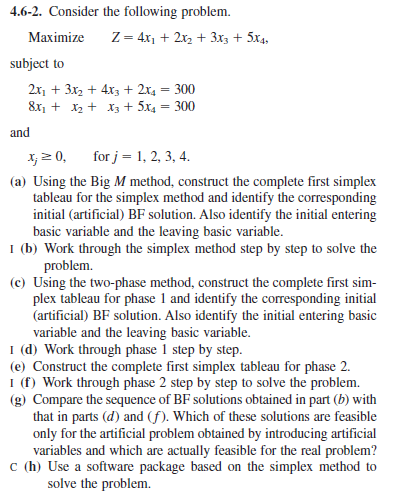4.6-2. Consider the following problem. Maximize Z = 4x₁ + 2x₂ + 3x3 + 5X4, 2x₂ + 3x₂ + 4x3 + 2x₁ = 300 8x₁ + x₂ + x3 + 5x₁ = 300 x ≥ 0, for j = 1, 2, 3, 4. (a) Using the Big M method, construct the complete first simplex tableau for the simplex method and identify the corresponding initial (artificial) BF solution. Also identify the initial entering basic variable and the leaving basic variable. 1 (b) Work through the simplex method step by step to solve the problem. (c) Using the two-phase method, construct the complete first sim- plex tableau for phase 1 and identify the corresponding initial (artificial) BF solution. Also identify the initial entering basic variable and the leaving basic variable. 1 (d) Work through phase 1 step by step. (e) Construct the complete first simplex tableau for phase 2. 1 (f) Work through phase 2 step by step to solve the problem. (g) Compare the sequence of BF solutions obtained in part (b) with that in parts (d) and (f). Which of these solutions are feasible only for the artificial problem obtained by introducing artificial variables and which are actually feasible for the real problem? c (h) Use a software package based on the simplex method to solve the problem. subject to and
4.6-2. Consider the following problem. Maximize Z = 4x₁ + 2x₂ + 3x3 + 5X4, 2x₂ + 3x₂ + 4x3 + 2x₁ = 300 8x₁ + x₂ + x3 + 5x₁ = 300 x ≥ 0, for j = 1, 2, 3, 4. (a) Using the Big M method, construct the complete first simplex tableau for the simplex method and identify the corresponding initial (artificial) BF solution. Also identify the initial entering basic variable and the leaving basic variable. 1 (b) Work through the simplex method step by step to solve the problem. (c) Using the two-phase method, construct the complete first sim- plex tableau for phase 1 and identify the corresponding initial (artificial) BF solution. Also identify the initial entering basic variable and the leaving basic variable. 1 (d) Work through phase 1 step by step. (e) Construct the complete first simplex tableau for phase 2. 1 (f) Work through phase 2 step by step to solve the problem. (g) Compare the sequence of BF solutions obtained in part (b) with that in parts (d) and (f). Which of these solutions are feasible only for the artificial problem obtained by introducing artificial variables and which are actually feasible for the real problem? c (h) Use a software package based on the simplex method to solve the problem. subject to and
Linear Algebra: A Modern Introduction
4th Edition
ISBN:9781285463247
Author:David Poole
Publisher:David Poole
Chapter2: Systems Of Linear Equations
Section2.4: Applications
Problem 2EQ: 2. Suppose that in Example 2.27, 400 units of food A, 500 units of B, and 600 units of C are placed...
Related questions
Question

Transcribed Image Text:4.6-2. Consider the following problem.
Маaximize
Z = 4x, + 2x2 + 3x3 + 5x4,
subject to
2x, + 3x2 + 4x3 + 2x4 = 300
8x1 + X2 + X3 + 5x4 = 300
and
X, 2 0,
for j = 1, 2, 3, 4.
(a) Using the Big M method, construct the complete first simplex
tableau for the simplex method and identify the corresponding
initial (artificial) BF solution. Also identify the initial entering
basic variable and the leaving basic variable.
I (b) Work through the simplex method step by step to solve the
problem.
(c) Using the two-phase method, construct the complete first sim-
plex tableau for phase 1 and identify the corresponding initial
(artificial) BF solution. Also identify the initial entering basic
variable and the leaving basic variable.
I (d) Work through phase 1 step by step.
(e) Construct the complete first simplex tableau for phase 2.
I (f) Work through phase 2 step by step to solve the problem.
(g) Compare the sequence of BF solutions obtained in part (b) with
that in parts (d) and (f). Which of these solutions are feasible
only for the artificial problem obtained by introducing artificial
variables and which are actually feasible for the real problem?
c (h) Use a software package based on the simplex method to
solve the problem.
Expert Solution
This question has been solved!
Explore an expertly crafted, step-by-step solution for a thorough understanding of key concepts.
This is a popular solution!
Trending now
This is a popular solution!
Step by step
Solved in 7 steps

Recommended textbooks for you

Linear Algebra: A Modern Introduction
Algebra
ISBN:
9781285463247
Author:
David Poole
Publisher:
Cengage Learning

Linear Algebra: A Modern Introduction
Algebra
ISBN:
9781285463247
Author:
David Poole
Publisher:
Cengage Learning